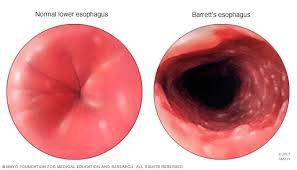Barrett's esophagus is a condition where the normal lining of the esophagus is replaced by tissue that resembles the lining of the intestine. It is often associated with long-term gastroesophageal reflux disease (GERD). Here are 20 potential causes, signs and symptoms, effects, and solutions related to Barrett's esophagus:
**Causes:**
1. Chronic GERD: Long-term exposure to stomach acid can lead to Barrett's esophagus.
2. Hiatal Hernia: A hiatal hernia can contribute to GERD and Barrett's.
3. Age: It's more common in older individuals.
4. Male Gender: Men are more frequently affected than women.
5. Obesity: Excess body weight increases the risk of both GERD and Barrett's.
6. Smoking: Smoking can weaken the lower esophageal sphincter, leading to GERD.
7. Alcohol: Excessive alcohol consumption can trigger GERD.
8. Genetics: A family history of Barrett's esophagus may increase risk.
9. Diet: High-fat or spicy foods can worsen GERD.
10. Pregnancy: Hormonal changes and increased abdominal pressure can contribute.
11. Medications: Some drugs may relax the lower esophageal sphincter.
12. Helicobacter pylori Infection: Although less common, this bacterial infection may play a role.
13. Delayed Stomach Emptying: Conditions like gastroparesis can lead to reflux.
14. Asthma: This condition may increase the risk of GERD.
15. Connective Tissue Disorders: Conditions like scleroderma can affect the esophagus.
16. Radiation Therapy: Chest radiation can contribute to Barrett's esophagus.
17. Occupational Exposures: Certain jobs involving chemical exposure may be a risk factor.
18. Zollinger-Ellison Syndrome: A rare condition that increases stomach acid production.
19. Celiac Disease: An autoimmune disorder associated with Barrett's.
20. Chronic Vomiting: Frequent vomiting can lead to acid exposure.
**Signs and Symptoms:**
1. No Symptoms: Barrett's esophagus often presents without noticeable symptoms.
2. Heartburn: A burning sensation in the chest.
3. Regurgitation: Backflow of stomach contents into the throat.
4. Difficulty Swallowing: Dysphagia or a feeling of food getting stuck.
5. Chest Pain: May mimic heart-related pain.
6. Belching: Frequent burping, often after meals.
7. Hiccups: Persistent or frequent hiccups.
8. Nausea: Feeling sick to the stomach.
9. Vomiting Blood: A sign of potential complications.
10. Weight Loss: Unexplained weight loss may occur.
11. Chronic Cough: May persist even with treatment.
12. Hoarseness: Voice changes due to irritation.
13. Sore Throat: An inflamed or painful throat.
14. Excessive Saliva: Increased saliva production.
15. Respiratory Issues: Such as asthma-like symptoms.
16. Bitter Taste in Mouth: Due to regurgitated stomach acid.
17. Bad Breath: Halitosis can be a symptom.
18. Throat Clearing: Frequent need to clear the throat.
19. Abdominal Pain: Discomfort in the upper abdomen.
20. Fatigue: Disrupted sleep due to symptoms.
**Effects:**
1. Increased Cancer Risk: Barrett's esophagus is a known precursor to esophageal adenocarcinoma.
2. Esophagitis: Inflammation and irritation of the esophagus.
3. Strictures: Narrowing of the esophagus due to scarring.
4. Bleeding: Ulcers or erosions can lead to bleeding.
5. Dysplasia: Precancerous changes in the Barrett's tissue.
6. Aspiration Pneumonia: Inhaling stomach contents into the lungs.
7. Chronic Pain: Ongoing discomfort and pain.
8. Anemia: Due to chronic bleeding.
9. Reduced Quality of Life: Due to pain and dietary restrictions.
10. Malnutrition: Difficulty eating may lead to nutrient deficiencies.
11. Respiratory Problems: Breathing difficulties, especially at night.
12. Sleep Disturbances: Disrupted sleep due to symptoms.
13. Dental Problems: Acid exposure can harm tooth enamel.
14. Increased Medical Costs: Ongoing monitoring and treatment.
15. Psychological Impact: Stress and anxiety.
16. Adverse Effects of Medications: Medication side effects may occur.
17. Weight Loss: Due to difficulty eating.
18. Complications in Pregnancy: Increased risk of complications during pregnancy.
19. Infection: Risk of infection if tissue becomes damaged.
20. Impact on Social Life: Dietary restrictions and symptoms can limit social activities.
**Solutions:**
1. Lifestyle Modifications: Weight loss, dietary changes, and smaller, more frequent meals.
2. Medications: Proton pump inhibitors or H2 blockers to control acid reflux.
3. Endoscopic Surveillance: Regular monitoring of the esophagus for dysplasia.
4. Radiofrequency Ablation (RFA): A procedure to remove abnormal tissue.
5. Photodynamic Therapy (PDT): Light-based therapy to treat Barrett's.
6. Surgical Intervention: In cases of high-grade dysplasia or cancer.
7. Diet Management: Avoiding trigger foods and maintaining a healthy diet.
8. Smoking Cessation: Quitting smoking to improve esophageal health.
9. Weight Management: Achieving and maintaining a healthy weight.
10. Stress Management: Techniques to reduce stress and anxiety.
11. Regular Follow-Up: Ongoing monitoring for disease progression.
12. Dental Care: Regular dental checkups and oral hygiene.
13. Esophageal Dilation: In cases of strictures.
14. Support Groups: Connecting with others who have Barrett's.
15. Medication Review: Evaluation of medications that may worsen reflux.
16. Dietary Counseling: Working with a dietitian for proper nutrition.
17. Esophagectomy: Surgical removal of the esophagus in severe cases.
18. Psychotherapy: Managing the psychological impact of the condition.
19. Infection Prevention: Ensuring proper wound care and hygiene.
20. Educating Family: Helping loved ones understand the condition and its impact.
Management of Barrett's esophagus should be individualized based on the patient's specific condition and needs. Consulting a healthcare professional is essential for proper diagnosis and treatment planning.


